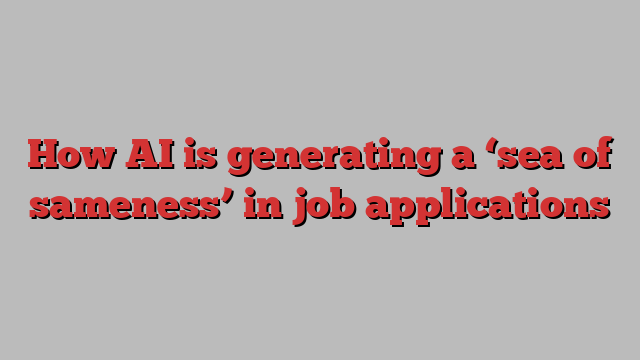
As UK vacancies have fallen over the past couple of years, jobseekers have had to find novel methods to stand out from the deluge of applicants vying for each available role.
New technologies such as generative AI and improved digital tools have made it easier and quicker to create sophisticated CVs and cover letters far removed from the dull Times New Roman font on an otherwise blank A4 page printout.
But there is a downside. “Everyone is dealing with a sea of sameness, where content that is created tends to look and feel the same,” says Govind Balakrishnan, senior vice-president of Adobe Express, a creative platform. This pattern quickly led to a homogeneity of job applications, where most CVs and cover letters follow a similar format and often lack individuality.
Part of the reason is that many applicants simply pick one of the preset CV templates offered by their software provider. These can be customised with text and images, but tend to look similar. Recently, however, Balakrishnan says he is seeing an “increasing number of users coming in and doing new things”, such as adding animations to their CVs or producing video applications.
“We all know how hard it is to stand out and grab people’s attention, especially when recruiters are pressed for time and overwhelmed with CVs that look the same,” Balakrishnan notes, but he suggests users should be mindful when experimenting with new formats for applications. “If you don’t strike the right balance, it could end up looking gimmicky and backfire like there’s no tomorrow.”

One of Adobe’s rivals, Sydney-based Canva, offers similar design tools and saw more than 900mn users create CVs on its platform last year. In a survey of 5,000-plus hiring managers, conducted by Canva, 39 per cent said their biggest grievance with CVs was that they included too much text.
Duncan Clark, the company’s head of Europe, says there is now a trend for linking out to additional information or attaching a separate portfolio of work, preserving your CV as “more of an elegantly typeset document that is short, concise and captures the key points in a very readable way.
“What we have seen is a growing thirst for visual communication,” Clark says, adding that digital tools made it possible for those without specialist design skills to “present themselves in a visually compelling way . . . without any training”.
By altering design features such as colours, layout and graphics, applicants can enhance the visual appeal of their submissions, he adds.
Canva’s research also found that nearly 45 per cent of jobseekers used generative AI to build, update or improve their CVs, which they said yielded positive results.
Over the past year, AI chatbots such as OpenAI’s ChatGPT and Google’s Bard have made it easy to generate large passages of text using generative AI that are comparable to human writing. The technology is particularly adept with natural language due to being trained on vast amounts of text data, which means that applicants are able to enter a job description into the chatbot and ask it to generate a cover letter or respond to questions. They can also enter their own CVs into the system, ask for feedback or amendments, and make the text more specific to the role requirements.
However, generative AI is known for repeating itself and plagiarising answers, leading to some applications having precisely the same text as others.
“We are seeing lots more people just pasting the form into ChatGPT and . . . we are getting a barrage of similar kinds of structures,” says Khyati Sundaram, chief executive of Applied, a recruitment platform. “In the worst instances, we’re getting just plagiarised answers. So they’ve copied and pasted the exact answer.”
Applicants caught using AI in this way have found they are swiftly rejected, leaving them frustrated. But some employers are finding themselves overwhelmed by the high numbers of AI-generated submissions.
Neurosight, based in Kent, works with companies including Virgin Media, the NHS and Auto Trader to create online prehire assessments and offer advice on eliminating bias in tests.
“There is an anxiety around people using generative AI to fake a version of themselves that is not true,” says Jamie Betts, Neurosight founder and chief product officer, adding that companies worry this could lead to bad hires.
“At the moment, we’re in a position where people are still quite naively using it and copying and pasting directly from it. I think once they’ve been rejected 10 times in a row because the employers are spotting that, they [will learn] how to use the right prompts to evade detection.”
Nicky Hutchinson, employability and careers consultant at the University of Exeter, says she has encountered students who were rejected from multiple roles after writing their applications using generative AI.
“If everybody [uses the same chatbot], it uses the same phrases. It’s really generic,” she says. “AI is a really helpful tool, but I think when it’s trying to do too much for you, it kind of erases your personality.”
Hutchinson suggests that AI tools are best used to generate potential interview questions or to help with tasks such as structuring applications, which candidates can then “inject themselves into”.
She warns that using generative AI or templates for CVs without enough thought or personalisation can result in “very bland” results.
Her advice to those keen to make their CVs more aesthetically pleasing is to ensure that this is “not at the expense of the content that is in it, because the designs can sometimes be quite restrictive in terms of space”.